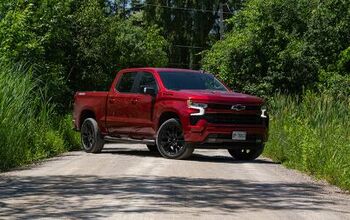2025 Ford Explorer First Drive Review: It's The Inside That Counts

Ford’s venerable SUV sees a range simplification and welcome quality improvements.
The Explorer has consistently been one of the best-selling SUVs on the market since it launched way back in 1990. With millions on the road, it’s a known quantity—especially as one of the main choices for law enforcement. Despite a return to a rear-drive-based platform, the current generation has struggled to recapture the magic against an onslaught of strong competitors from Japan and Korea.
The weak point? A cabin that felt cheap but not cheerful.
No more.
The 2025 Ford Explorer sees a substantial—and welcome—cabin upgrade, along with better technology, a simpler trim lineup, and tweaked styling. Ford of Canada invited us to its HQ to spend a day getting to know the new lineup. The result is a likable three-row SUV that goes much further towards justifying its pricing.
Quick Take
The 2025 Ford Explorer sees detail changes to keep it fresh in one of the most competitive segments. Still not a class leader, it nonetheless offers buyers a rare rear-drive-biased, towing-friendly alternative—one with more available power than most.
2025 Ford Explorer First Drive Review: All The Details
What’s New for 2025:
A modest facelift gives the Explorer extra flash for ‘25. Redesigned headlights frame a larger, upright grille, which features a different pattern for each trim. The flanks are largely the same, including the signature reverse-rake C-pillar. Around back, Ford simply couldn’t resist the full-width taillight trend, a thick fade-away unit now connecting the previous taillight shapes. Standard rolling stock consists of 18-inch alloys on the Active, with 20s and 21s elsewhere.
Yes, the Explorer is following the Escape’s trim walk now. What was once eight trims is now four. Active serves as the entry point; ST-Line adds on-road aggression; Platinum is the fancy-pantsiest, and ST remains the top performance trim.
Engines once again consist of a pair of EcoBoost models, a 2.3-liter four-cylinder and 3.0-liter V6. The unloved hybrid model quietly disappears. Rear-wheel drive is standard—a class rarity—with four-wheel drive optional.
Exterior Style:
The visual changes give the Explorer a more assertive presence. The headlights are more elegant than the simple wedges of before, yet the big grille tells people this is a large, rugged(ish) SUV. Ford expects the 20s to be a popular option on the Active, and the simple yet attractive design fills out the wheel wells nicely.
We start the day in the swanky Platinum and ladles on the glitz, with a chrometastic front grille and brightwork along the bottoms of the doors. Meanwhile, the ST remains the dramatic on-road performer, with big 21-inch wheels as standard and a gaping, blacked-out grille.
Powertrain and Fuel Economy:
The V6-powered Platinum is a genuinely quick three-row SUV. With 400 horsepower and 415 pound-feet of torque, it has no issues getting up to highway speeds, and even has an appealing (piped-in) soundtrack to go along with the shove. Ford has refined the 10-speed auto’s manners too, resulting in far less gear-hunting than previous examples.
This is even more noticeable in the Active we sample after lunch. The 2.3-liter still puts out class-competitive power (300 hp and 310 lb-ft of torque), yet it feels so much more refined than before. No longer is it spending more time deciding on a gear than actually using one. Impressively, it even sounds… well, fine. Better than the last EcoBoost Mustang I drove, anyway.
Fuel economy is class-competitive: the combined figures range from 24 to 21 miles per gallon depending on number of cylinders and driven wheels. In Canada, where 4WD is standard, the combined figures vary between 10.4 or 11.6 L/100 km. Helpfully, both engines run on 87-octane fuel.
Handling and Drivability:
Those wanting the most agile performer should head towards the Explorer ST, which features a sport-tuned suspension. We weren’t able to drive it on the day, but the Platinum is arguably the better choice for most people. The V6 is optional here for the same poke, but the softer suspension settings make it more family-friendly. There’s a predictable amount of weight to the steering, with easy turn-in and good highway manners. The Explorer is surprisingly light for its class considering the rear-drive platform, but it never feels small on the road. Nonetheless, the extremities are easy to place, though that C-pillar does impede visibility.
The Active is largely the same story, though its 20-inch alloys give it a slightly softer edge, both in its responses and its highway ride.
With the most ground clearance (8.2 inches / 208 millimeters), the Platinum made short work of the light off-roading tasks we had in the morning. A dedicated driving mode loosens up the traction control and softens throttle response for easier modulation, while Hill Descent Control takes the guesswork out of the equation. Don’t expect those road-biased 21-inch tires to allow the Explorer to start following Broncos on the trail, but for the yearly trip to the cottage the Explorer should more than suffice.
Ride Quality and Comfort:
The Explorer is in its element on the highway, where its long wheelbase and soft suspension work in harmony. The big SUV is stable and confident here, and keeps wind noise to a minimum. On craggy backroads the Explorer filters out all but the worst bumps, though riders will hear the rear suspension putting in that work.
Front-seat comfort remains another Explorer strength. The seating position is natural: elevated, but still easy to access, with a good range of adjustments available. The Active’s synthetic-covered seats look flat but offer good lower back support. Platinum buyers will find the same shape of seats, but done up in quilted leather. Second-row captain’s chairs lack lateral support but there’s good amounts of head- and legroom. I fit fine in the third row, and the trek back there isn’t too hard, but the cushion is very low and that huge C-pillar makes it feel even tighter.
Interior Style and Quality:
This is where the big changes happen. The pre-facelift Explorer had one of the least impressive interiors in its class. Ford has made a concerted effort to improve the fit, finish, and materials in here, and even on the entry-level Active, it’s clear. A knit from the Mustang Mach-E now adorns the top of the dashboard, with a ever so slightly bronze bit of metallic trim bisecting the main volume. The color coordination continues into the door panels, too. In the swanky Platinum, there’s an unusual digital-camo-like wood texture that is clearly not real tree, but provides visual interest nonetheless. Here, buyers have two leather color options: the Salt Crystal Grey we experience and an excellent Mojave Dusk, which is almost mulberry in the sun.
On the practical side, the door cubbies easily hold large water bottles, and there is a useful amount of storage both on and in the center console.
Are there a few low-rent pieces of plastic still circulating near the bottom of the cabin? Do other competitors still feel more premium for a lower price? Yes on both counts, but the Explorer now holds its own, no excuses necessary.
Tech and Safety:
The other big in-cabin improvement comes in the form of the twin screens on the dashboard. A 13.2-inch touchscreen sits proud of the dashboard, while a 12.3-inch digital instrument cluster takes up residence behind the wheel. Both have super-sharp graphics and quick response times. The central screen debuts the Ford Digital Experience, the next-generation system supplanting SYNC. With Google built-in, navigation is easy-peasy, and a voice assistant is on-hand should you desire—as is Amazon Alexa. We found pairing mobile devices simple, and the setup allows owners to easily download additional third-party apps. This includes video options such as YouTube and even video games—accessible only while the vehicle is parked, of course.
The Explorer comes with a laundry list of standard safety kit, including useful features like blind-spot monitoring. A 360-camera is included on the ST-Line and up.
Most importantly, Ford’s excellent BlueCruise hands-free highway driving assist is also available on all models bar the Active. It ships with version 1.2 as well, which unlocks assisted lane changes. It’s a smooth system: just tap the indicator, the vehicle scans for an appropriate gap and, should it exist, moves over one lane and cancels the turn signal. It’s a more gradual move than I’d like, but it works consistently. While cruising, BlueCruise will also adjust the vehicle’s position in the lane based on traffic conditions. Big 18-wheeler beside you? The Explorer shifts for more space. This is very subtle, yet welcome.
The catch? BlueCruise is free at purchase, for up to a year depending on market. After that, however, it’s a subscription, at $800 per year in America or $2,500 CAD for three years in Canada.
Value Dollars and Sense:
With the fleet-friendly former base trim put to pasture, the entry point of the 2025 Explorer lineup is now the Active. The rear-drive model starts from $41,350 including destination; opting for 4WD puts the price at $43,350 ($52,730 CAD). Adding on the Comfort Package costs $3,360, or just $2,000 CAD in Canada, where more of the features are included as standard. Our Active tester comes just so equipped, plus the twin-panel moonroof ($1,695 / $1,850 CAD), for a solid all-rounder with easy-clean seating.
The Platinum starts at $53,745 ($62,830 CAD), slightly below the ST by dint of using the four-cylinder as standard. Going for the V6 forces the ultimate package ($4,615 / $9,500 CAD), which means a loaded model starts encroaching on genuinely premium options.
Final Thoughts:
The 2024 Explorer was a hard vehicle to recommend. Unless folks were sold on rear-drive architecture or the sporty ST, it struggled to stand out. Well, except for the cabin, which felt a generation behind. That changes with the 2025 Explorer. The massive tech jump and thoughtful material improvements make for a much stronger package. Along with the refined transmission logic, the Explorer is once again a solid choice in a segment littered with them.
Become an AutoGuide insider. Get the latest from the automotive world first by subscribing to our newsletter here.
Pros | Cons |
|---|---|
Much better interior | Third row still tight |
Improved 10-speed | Still pricier than most rivals |
BlueCruise availability | BlueCruise subscription costs |
Engine/Motor: | 2.3L I4 Turbo / 3.0L V6 Turbo |
Outputs: | 300 hp, 310 lb-ft / 400 hp, 415 lb-ft |
Drivetrain: | RWD/4WD |
Transmission: | 10AT |
US Fuel Economy (mpg): | 20/29/24 (I4 RWD) / 18/25/21 (V6 4WD) |
CAN Fuel Economy (L/100 km): | 11.9/8.7/10.4 (I4 4WD) / 13.3/9.6/11.6 (V6 4WD) |
Maximum Towing Capacity | 5,000 lb / 2,268 kg |
US Starting Price: | $41,350 (inc. dest.) |
US As-Tested Price: | See text |
CAN Starting Price: | $52,730 (inc. dest.) |
CAN As-Tested Price: | See text |

Kyle began his automotive obsession before he even started school, courtesy of a remote control Porsche and various LEGO sets. He later studied advertising and graphic design at Humber College, which led him to writing about cars (both real and digital). He is now a proud member of the Automobile Journalists Association of Canada (AJAC), where he was the Journalist of the Year runner-up for 2021.
More by Kyle Patrick


























![2011 Ford Explorer Review - First Drive [Video]](https://cdn-fastly.autoguide.com/media/2023/06/26/06072/2011-ford-explorer-review-first-drive-video.jpg?size=350x220)















Comments
Join the conversation
I had two Explorers back in the 1990’s and they were reliable but not very off-road worthy. Since then I have had Grand Cherokee’s exclusively and have found them to be as nice around town as the Explorer, but far better once the pavement ends. Ford needs to make a Tremor version of the Explorer available. If they can make it for the Maverick, the Explorer should be a cinch.